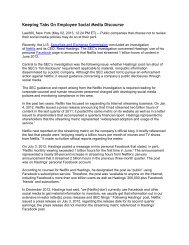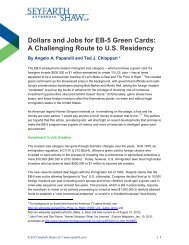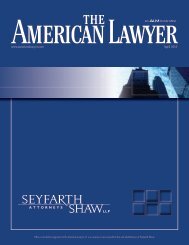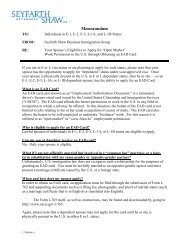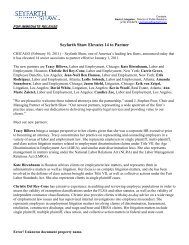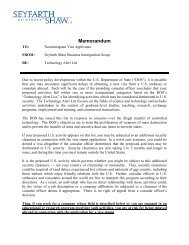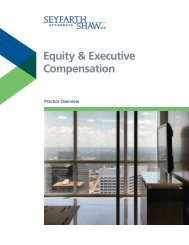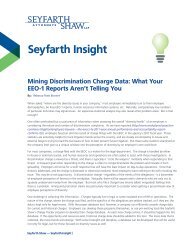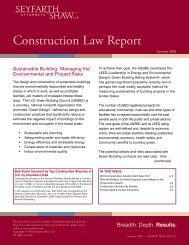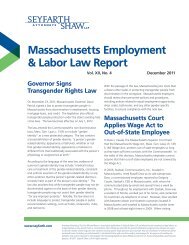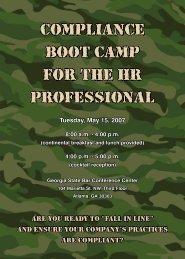Litigating California Wage & Hour and Labor Code Class Actions
Litigating California Wage & Hour and Labor Code Class Actions
Litigating California Wage & Hour and Labor Code Class Actions
You also want an ePaper? Increase the reach of your titles
YUMPU automatically turns print PDFs into web optimized ePapers that Google loves.
First, there has been a substantial dispute whether the language in subsection (e) that an employee<br />
must “suffer injury” to recover the penalties means that only employees suffering actual harm from<br />
a wage statement violation can recover. Defendants, arguing that there must be actual harm to<br />
“suffer injury,” rely on the definition of “injury” as used in other aspects of <strong>California</strong> law. 211<br />
Defendants also support their position by pointing out that employees who did not suffer actual<br />
injuries could obtain injunctive relief pursuant to <strong>Labor</strong> <strong>Code</strong> Section 226(g), which does not contain<br />
language about “suffering injury.”<br />
Plaintiffs, by contrast, argue that the term “injury” is simply the violation of one’s legal rights. 212<br />
Plaintiffs argue that Section 226 creates a right for employees to receive an accurate wage<br />
statement, <strong>and</strong> that right is violated when the employer knowingly provides a defective wage<br />
statement. By this logic, any violation of Section 226(a) causes an injury sufficient to trigger<br />
penalties under Section 226(e).<br />
Recent decisions have ruled for defendants. The <strong>California</strong> Court of Appeal found that the lack of<br />
certain information on a wage statement, by itself, does not constitute injury under Section 226. 213<br />
The Ninth Circuit Court of Appeals has also reached the same result. 214 And the <strong>California</strong><br />
Supreme Court decision of Meyer v. Sprint Spectrum, L.P., 215 provides some support for employers<br />
on the issue of the level of damages needed for an employee to bring a 226 claim. While not an<br />
employment case, Meyer held that damages alleged by the representative plaintiff in a consumer<br />
class action must be real <strong>and</strong> not merely theoretical. The court specifically rejected the notion that<br />
just being subject to an unlawful practice equates to being injured by the practice. 216 While this<br />
reasoning could be helpful to employers in wage statement cases, it remains to be seen whether<br />
courts will apply the same logic to such matters.<br />
211<br />
212<br />
213<br />
214<br />
215<br />
216<br />
See, e.g., Steketee v. Lintz, Williams & Rothberg, 38 Cal. 3d 46, 55 (1985) (“The word ‘injury’ signifies both the<br />
negligent cause <strong>and</strong> the damaging effect of the alleged wrongful act <strong>and</strong> not the act itself.”); Lueter v. State of Cal., 94<br />
Cal. App 4th 1285, 1303 (2002) (“‘Injury’ refers to the fact of harm suffered by the plaintiff due to the defendant’s<br />
conduct.”); San Fran. Unified Sch. Dist. v. W.R. Grace & Co., 37 Cal. App. 4th 1318, 1330 (1995) (“[W]hen injury or<br />
damage is the last element of a tort cause of action to occur, the cause of action accrues once any actual <strong>and</strong><br />
appreciable harm has occurred.”).<br />
See, e.g., BLACK’S LAW DICTIONARY 466 (4th ed. 1968) (“the injury is the violation of the legally protected interest . . . <strong>and</strong><br />
not necessarily the resulting harm”); Migliori v. Boeing N. Am., Inc., 97 F. Supp. 2d 1001, 1007 (C.D. Cal. 2000)<br />
(distinguishing “injury” from “damages” for purposes of res judicata analysis).<br />
Price v. Starbucks Corp., 192 Cal. App. 4th 1136, 1143 (2011) (plaintiff’s claim that he suffered a “mathematical injury”<br />
because his pay statements “required him to add up his overtime <strong>and</strong> regular hours <strong>and</strong> to ensure his overtime rate of<br />
pay is correct” is ”not the type of mathematical injury that requires ‘computations to analyze whether the wages paid in<br />
fact compensated [him] for all hours worked.’” (quoting Jaimez v. Daiohs U.S.A., Inc., 181 Cal. App. 4th 1286 (2010));<br />
see also, Nguyen v. Baxter Healthcare Corp., 2011 WL 6018284 (C.D. Cal., Nov. 28, 2011) (relying on Price in granting<br />
summary judgment for employer, <strong>and</strong> noting that mathematical injury was insufficient to establish an inaccurate wage<br />
statement claim). .<br />
Villacres v. ABM Industries Inc., 384 F. App’x 626, 627-28 (9th Cir. 2010) (holding § 226, violation does not constitute<br />
injury under <strong>California</strong> law).<br />
45 Cal. 4th 634 (2009).<br />
Id. at 641.<br />
Seyfarth Shaw LLP | www.seyfarth.com <strong>Litigating</strong> <strong>California</strong> <strong>Wage</strong> & <strong>Hour</strong> <strong>Class</strong> <strong>Actions</strong> (12th Edition) 51



